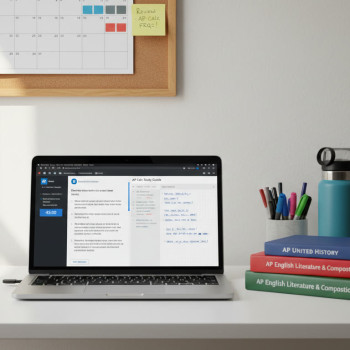Imposter Syndrome: Facts Versus Feelings
You open your notebook, skim the outline for the third time, and a familiar thought creeps in: “I don’t really belong here. Everyone else just gets it.” If you’re preparing for AP exams, that whisper is painfully common—and it’s called impostor syndrome. It isn’t a secret failing or a sign that you actually can’t do the work. It’s a feeling—one that affects many high-achieving students, including those walking into AP classrooms around the world.

Why this matters for AP students
AP courses are designed to be challenging: they push you into more sophisticated thinking, deeper evidence-based reasoning, and faster pace than many standard classes. That challenge is growth by design—but it can also trigger self-doubt. When doubts become constant, they erode focus, increase procrastination, and make exam performance worse, which ironically seems to ‘prove’ the doubt true. The good news: impostor feelings are normal, detectable, and manageable.
What Imposter Syndrome Really Is (and Isn’t)
Imposter syndrome is a psychological pattern where competent people attribute their success to luck, timing, or deceiving others rather than skill. Importantly, it’s a feeling—an interpretation—not an objective diagnosis of ability. Knowing the difference between facts and feelings gives you power to act.
Facts about impostor feelings
- Many high-achieving students experience it—top performers, honor students, and AP candidates included.
- It often peaks around transitions and evaluations: starting a new class, after receiving grades, or when preparing for exams.
- It’s not the same as clinical anxiety or depression, though it can co-occur and worsen them.
- Strategies—both mental and practical—can reduce its frequency and intensity.
Common unhelpful beliefs students hold
- “If I were smart, I wouldn’t need help.”
- “Everyone else understands this better than I do.”
- “One bad test means I’m not cut out for this subject.”
Replacing those beliefs with evidence-based thinking changes how you show up in study sessions and exams.
Spotting the Pattern: How Imposter Thoughts Show Up
Imposter syndrome is more than a single thought; it’s a pattern. Here are the ways it often appears for AP students:
- Perfectionism: You delay submitting practice essays because they’re “not quite perfect.”
- Discounting success: You call a 5 on a practice test a fluke rather than evidence of ability.
- Comparison trap: Social media and classmates’ highlight reels make your progress look smaller than it is.
- Overpreparing or underpreparing: Both are avoidance strategies—either you grind endlessly to feel “safe” or you procrastinate to avoid the risk of failure.
Quick self-check: Are these your go-to responses?
- “If I ask for help, they’ll think I’m dumb.”
- “I guessed on that question but luckily I got it right.”
- “I must always perform at the top to justify being here.”
If more than one of these feels familiar, you’re not broken—you’re human, and you can use practical strategies to reframe the story.
Facts Versus Feelings: A Table to Keep Things Real
Use this compact table when your mind races: write a thought, then note whether it’s a feeling or a fact, and add a calm, fact-based rebuttal you can repeat.
| Automatic Thought | Feeling or Fact? | Calm Rebuttal (Evidence-Based) |
|---|---|---|
| “I got a B on the test—I’m going to fail the AP exam.” | Feeling | One test is a data point. My scores have trended upward after targeted study. With a plan, I can improve. |
| “Everyone else is better at this than I am.” | Feeling | Classmates may show their strengths; I have my own. I can ask targeted questions and practice skills I lack. |
| “I only passed because I guessed well.” | Feeling | Guessing can be skillful in multiple-choice strategy. My correct answers often reflect reading comprehension and reasoning I’ve practiced. |
Practical Strategies to Move From Feeling to Doing
Reframing thoughts helps, but you also need practical habits—study routines and accountability systems—that give measurable feedback. Combine the two for the best results.
1. Break goals into micro-actions
Ambitious goals like “master AP Biology” feel overwhelming. Replace them with daily or weekly micro-goals: “Master photosynthesis diagrams this week” or “Write one timed free-response every Wednesday.” Micro-goals build momentum and generate objective evidence of progress.
2. Keep a ‘Progress Notebook’
Write down two concrete wins after every study session—no matter how small. Over weeks, the notebook becomes an antidote to the memory bias that fuels impostor thinking.
3. Practice retrieval, not rereading
Rereading feels productive but is less effective than active recall. Use practice tests, flashcards, and short written explanations to force your brain to retrieve information—this builds durable confidence because you’ll have objective proof you remember and apply concepts.
4. Use deliberate practice with feedback
Deliberate practice means focusing on specific weak spots and getting feedback. If your essays lose points on evidence use, practice outlines and ask for targeted comments. If multiple-choice stems trip you up, practice untimed sets focusing on reasoning patterns.
5. Normalize help-seeking
Asking for help is evidence of sophistication, not weakness. Tutors, teachers, and peers are information sources—like lab equipment for building knowledge. Sparkl’s personalized tutoring, with 1-on-1 guidance and tailored study plans, can help you pinpoint gaps and provide expert feedback that makes practice efficient and confidence measurable.
Study Plans That Respect Your Brain
A plan that ignores how learning actually happens will feed stress. Here’s a study rhythm that balances effort and recovery—key to reducing impostor feelings.
- Weekly rhythm: Two deep study blocks (90 minutes each) + three focused retrieval sessions (25–40 minutes) + one practice test or timed essay every 7–10 days.
- Spaced repetition: Return to topics multiple times with increasing intervals to lock knowledge into long-term memory.
- Interleaving: Mix related topics or problem types in a single session so you learn to choose strategies, not just memorize steps.
- Recovery days: Active rest like light review, flashcards, or whole-body exercise helps consolidate learning and calm anxiety.
Sample weekly plan (for a single AP subject)
| Day | Focus | Time |
|---|---|---|
| Monday | Deep conceptual study (new topic) | 90 minutes |
| Tuesday | Active recall (flashcards + short problems) | 30 minutes |
| Wednesday | Practice FRQ/Essay (timed) | 60 minutes |
| Thursday | Interleaved problem set | 45 minutes |
| Friday | Review notes and corrections | 40 minutes |
| Saturday | Full practice test or mixed timed section | 2–3 hours |
| Sunday | Rest/Light review | Optional 20–30 minutes |
How to Use Feedback Without Taking It Personally
Feedback is data: it’s not a verdict on your worth. Switch to a scientist’s mindset—see mistakes as experiments that reveal the right next step.
- Before feedback: identify one question you want answered (e.g., “Do I use evidence clearly?”).
- After feedback: write three specific actions you will take next (not global vows like “study more”).
- Track results: after two weeks, compare the new practice score to the old one and iterate.
Working with a tutor can make this process faster. A thoughtful 1-on-1 tutor will translate comments into practical drills and help you test whether those drills actually move the score. Sparkl’s expert tutors combine tailored study plans with AI-driven insights to help you measure progress rather than rely on feelings alone.
Mental Tools That Help (Simple, Science-Friendly)
1. Cognitive reframing
When a thought like “I don’t belong” appears, practice the formula: label the thought, note the evidence, and choose a corrective action. Example: “Thought: I don’t belong. Evidence: I’ve earned my place and scored well on practice sets. Action: Review two past tests to find specific errors and fix them.” Repeat until it becomes automatic.
2. The ‘Fake It’ Tactic—Used Wisely
Acting confident can change your body language and performance. Briefly adopting confident posture or starting an answer with a clear statement primes better thinking. But pairing this with real preparation prevents it from becoming empty bravado.
3. Normalize mistakes publicly
Sharing a small struggle with a classmate or study group can be disarming. You’ll likely discover they have the same worry. Talking about it reduces isolation and makes solutions tangible.
When Your Feelings Signal Something Bigger
Imposter feelings are common, but sometimes underlying anxiety, sleep issues, or burnout are at play. Here are red flags that warrant extra attention:
- Persistent insomnia or sleep changes interfering with daily function.
- Loss of appetite or muscle tension with constant worry.
- Inability to concentrate despite a reasonable study plan and rest.
- Thoughts of hopelessness or inability to enjoy things you used to like.
If any of these are present, reach out to a school counselor, trusted adult, or health professional—mental health care is a legitimate part of academic success, not an admission of failure.
Real Student Examples: Reframing the Story
Here are two composite stories (based on common student experiences) showing how facts and feelings diverge—and how targeted actions change outcomes.
Case 1: Maya — From Perfection Paralysis to Progress
Maya thought she needed perfect essays before showing them to anyone. She waited weeks, stressed, and scored poorly in timed conditions. Her tutor suggested she submit a 20-minute draft every week and ask for one specific comment. Within a month, her timing improved, and the steady feedback highlighted a recurring issue with synthesis—something she could fix, not a sign she was an impostor.
Case 2: Jamal — When Comparison Clouded Confidence
Jamal watched classmates’ social posts celebrating high scores and assumed he was behind. He started tracking his own improvement: topic-by-topic score lists and mastery checks. Objective progress—two topics moved from 50% to 80% mastery in three weeks—quieted his doubt. He also started a brief tutoring check-in to make his study time more efficient and focused.
Practical Scripts: What to Say (and Do) When Doubt Strikes
Having a short script reduces cognitive load when stress hits. Try these aloud or write them on sticky notes.
- “This is a feeling, not a fact. What is one piece of evidence I have?”
- “I’ll do one productive step: 25 minutes on practice problems, then a 5-minute review.”
- “If I don’t know it yet, I can learn it. I will ask one clarifying question tomorrow.”
How Tutors and Personalized Support Amplify Progress
Strategic support shortens the feedback loop. A tutor can:
- Diagnose specific skill gaps vs. general knowledge gaps.
- Create a tailored study plan that matches your actual schedule and learning style.
- Offer immediate, actionable feedback on practice essays and problem approaches.
When feelings of being an impostor are strong, a coach or tutor is not a crutch—it’s a tool that turns feelings into measurable improvements. Sparkl’s personalized tutoring model emphasizes 1-on-1 guidance, tailored study plans, and expert tutors who translate feedback into growth, supported by AI-driven insights that help you see progress in charts and scores rather than judgments.
Preparing for Exam Day: Rituals That Reduce Imposter Moments
Exam morning rituals stabilize nerves so you can think clearly. Try this routine in the weeks beforehand so it becomes automatic on test day:
- Sleep ritual: consistent bedtime and wake time for two weeks before the exam.
- Morning routine: light breakfast with protein, 10 minutes of gentle movement, and a short review of one sheet of high-yield notes.
- Arrival plan: know your testing room, materials, and route to avoid last-minute surprises.
- Pre-test mental cue: a one-sentence affirmation grounded in fact, e.g., “I’ve practiced this skill; I will do my best work.”
Measuring Your Progress: What to Track
Track things that actually predict performance, not feelings. Examples:
- Percent correct by topic on practice sets.
- Average time per multiple-choice question and improvement over time.
- Score improvements on full-length practice tests and FRQ rubric-based feedback.
When you track these, you’ll see the curve of improvement—evidence that undercuts impostor feelings.
Putting It All Together: A 6-Week Recovery Plan from Imposter Mode
Use this short roadmap if self-doubt is interfering with study. It’s a blend of mindset shifts and measurable practice.
- Week 1: Baseline—take a timed practice test and start a Progress Notebook. Write down three wins this week.
- Week 2: Micro-goals—set two specific topics to improve, use daily 25-minute retrieval sessions.
- Week 3: Deliberate practice—focus on weak items identified in the baseline; use targeted feedback from a teacher or tutor.
- Week 4: Interleaved practice and timed sections—simulate test conditions once per week.
- Week 5: Full-length practice test and score analysis—adjust study plan accordingly.
- Week 6: Consolidation—light review, sleep prioritization, and rehearsal of exam day routines.
If you want faster iteration, pairing this roadmap with dedicated 1-on-1 sessions—where a tutor helps translate test results into drill work—can accelerate progress and reduce doubt. Sparkl’s personalized approach can fit into this plan naturally by offering tailored study plans and expert feedback at each step.
Final Notes: Rewriting Your Story
Imposter syndrome is persuasive because it twists facts into feelings. The cure isn’t blind optimism; it’s a steady combination of reality checks, targeted practice, and supportive feedback loops. For AP students, the last months before the exam are the perfect time to convert anxiety into evidence: measurable scores, improved timing, clearer essays, and a notebook full of wins.
Remember, every student who looks confident in class has had nights of doubt and small daily habits that led to competence. You’re allowed to be learning and to need help; those are part of growing. Use the strategies above, track real progress, and when it fits, lean on personalized support systems like Sparkl’s tutoring to speed the feedback loop. Your feelings are valid—your facts can be stronger.
Quick takeaway: When doubt arrives
- Label the thought. Ask: “Is this a feeling or a fact?”
- Do one micro-action that produces evidence (25 minutes of focused practice).
- Log the result and iterate. Repeat until the evidence outweighs the doubt.
AP success is built on small, evidence-backed steps. Start today with one focused session and one recorded win. Confidence follows competence—one practice session, one test question, one corrected mistake at a time.

You’ve got this. And if you ever need tailored guidance that meets you where you are—mapping gaps into a clear plan and tracking real wins—there are 1-on-1 options designed to help students turn feelings into facts. Study hard, be kind to yourself, and let progress speak louder than perfectionism.



















No Comments
Leave a comment Cancel